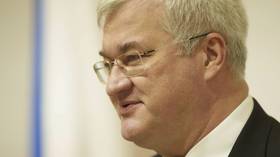‘The curious case of Benjamin Mouse’: Aging reversal coming soon?

Mice have become the first creatures to experience the ‘Curious Case of Benjamin Button’ for real, as Australian and American scientists have managed to literally reverse their ageing process. And they say humans could be next in line.
The discovery is centered on a compound that is like a youth elixir, targeting and reversing muscle aging, building up muscle tone and reducing inflammation and giving mice more energy – as if they have been working out in the gym. Likewise, resistance to insulin was targeted, adding diabetes to an already impressive list of age-related diseases that could soon be fought, like neurodegenerative conditions and cancers.
The resulting research was published in the journal Cell on December 20.
"I've been studying aging at the molecular level now for nearly 20 years and I didn't think I'd see a day when aging could be reversed. I thought we'd be lucky to slow it down a little bit," said Professor David Sinclair, of the University of New South Wales. He was the leader of the study, working from Harvard Medical School in the United States.
The research was tested on 6-month-old and 22-monthold old mice, comparing first how aging occurred in general, then testing the new compound on the older mice to see if the “youth potion” worked.
An explanation as to how and why aging occurs can be seen in the levels of messenger ribonucleic acid (mRNA) in the nucleus and in the mitochondria, which begin to differ with age. These levels encode genetic information around a cell.
The mitochondria are where all the hard work takes place. All mammals create energy in the way that small molecules are created when larger ones break down, and energy is released. Skeletal muscle respiration is the result of this, and its swift functioning is key to age reversal, researchers explain.
"We have chromosomes that we all know about, we call it our genome, but there's other DNA that we often don't think about - the mitochondrial DNA that we get from our mothers… what we found is that during aging these two genomes, the chromosomes, don't talk to each other,” Sinclair said, comparing the two to an aging married couple.
Although a lot of the information is carried by the mitochondria, some functions responsible for muscular respiration are encoded in information stored in the nucleus. Therefore, a balanced and coordinated functioning of both is essential, as with age it begins to fail, like a telephone call interrupted by static.
The levels of mRNA in the mitochondria declined in the older ones. And the same was noticed for proteins called SIRT-1 and another one produced by the nucleus, whose levels are connected with a higher lifespan.
The healthy coordination between the nucleus and the mitochondria were found to lie directly in the amount of those proteins – especially SIRT-1: the higher the levels, the slower the aging.
However, a bigger problem was found to lay in the so-called NAD+ molecule, its levels in the nucleus. But scientists could not account for how exactly it kept SIRT-1 levels up. Its own levels simply dwindled with age.
"When we're young, we have the high levels of NAD and if we exercise and diet, the levels of this NAD molecule are high in our body… but as we get older, and as these mice in our experiments got older, the levels went down about 50 per cent and then we could give this drug to bring the levels back up again."
To try and cheat mice organisms into producing more SIRT-1, the scientists injected the 22-month old mice with nicotinamide mono nucleotide (NMN) – a molecule directly responsible for the levels of NAD, which conversely is known to lead to an increase in SIRT-1.
The experiment worked.
Professor Sinclair was astonished, telling Cell that “the mice had more energy, their muscles were as though they'd be exercising and it was able to mimic the benefits of diet and exercise just within a week.”
As a result, human trials appear not to be far off. "We think that should be able to keep people healthier for longer and keep them from getting diseases of aging," Sinclair continued, adding that the diseases we have come to expect of old age have been drastically reversed in mice: muscle atrophy dropped, and so did inflammations – which lead to arthritis. And the most important muscle in the body – the heart – simply reversed in age as a result.
All this happened in just one week.
And the startling results have scientists seriously considering human trials within the next year, as Sinclair himself confirms that they would like to make the compound available commercially soon.
Of course without rigorous testing on humans, this is not yet a possibility, but the professor has set up a company dedicated to just that. It is no easy task, as the costs are projected to be in the millions. But so far, money is the only challenge, so we may as well start to get ready to live longer, given what we have just learned.














